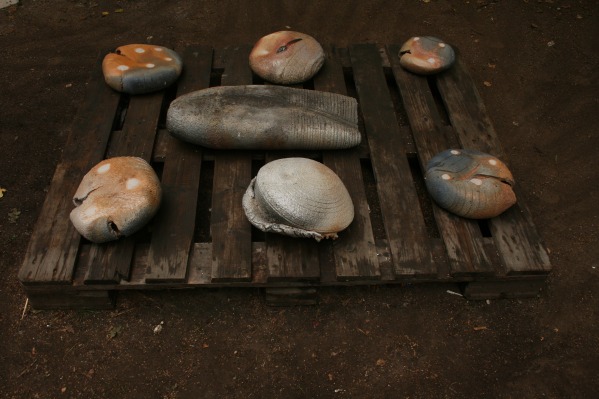
A Body Of Contention. 2010
Catalogue essay for “a body of contention”; exhibition in the National Gallery of Estonia
This body of work was made when I was invited to participate in the residency focussed on Anagama firing, at Kohilla in Estonia. This technique involves placing the work in a single-chamber kiln and setting a wood fire at one end. Work is placed in the path of the flame, (or shielded from it) and can also be buried in the ashes of the fire-pit – my preferred location for some pieces. This is a technique that I had researched extensively in the writing of my book on firing. The kiln was managed by one of the leading European kiln-masters, Andres Allik. My pieces were placed in the flame paths and the firebox, they emerged changed and charred by the ordeal, marked by the passage of fire; for me this technique brings echoes of the gas-ovens that had consumed so many members of my family including my grand-parents. The piece I made reflected not solely on their fate but also on the escape to England, by all the children of my grandmother. The title reflects the word that we use in ceramics to refer to a mixture of clays – which is “a clay body”.
A body of contention was an installation piece conceived for the National Gallery of Estonia, Tallinn. It was constituted by a group of pieces thrown on the potter’s wheel, altered and flattened and laid on an old (appropriated) wooden pallet. The pieces embody the history of their manufacture. They bear indexical traces – the marks of making and also the reactive marks on the clay surface caused by the path of the flame through the anagama kiln – exposure to fly-ash, cinder contact, and introduced combustibles, which occurs over the protracted duration of the firing, which results in a very hard (and thereby permanent) ceramic. There was a complementary group of porcelain pieces installed to re-iterate the form of the piece. The abstract, hollow ceramic vessel forms, stand for people.
My writing of Firing (2007) had resulted in a focus on the transformative aspects of fire, which led to a personal concern to investigate the theme of burning and making permanent of the marking of clay; this was afforded by an invitation to participate in the 10th anniversary International anagama firing symposium in Estonia. In my main technique of raku, where the piece undergoing fire is closest to hand of all ceramic firing techniques, the piece is acted on directly by the potter; I often intervene in the firing in the kiln and manoeuvre the work while it is still red-hot using thick gloves and tongs. The duration of a kiln firings can vary greatly: from the very short raku firing, (which can be as little as 30minutes to reach red-heat); 1-2 days for a conventional gas firing and 1-2 weeks for some extended anagama wood firings, in which the ceramic is isolated from the world in the kiln undergoing heat change.
The narrative embodied in the work was informed by my meditating on the aspects of fortune that lead to our being – the theme of my grandmother who had put her children on the Kindertransport from Leipzig to London, and then perished herself in the fires of the camps, unable to escape. In A body of contention, the objects are deeply burnt and scarred by the firing, emblematic of the emotional scarring that has occurred in my mother’s generation, a scarring that they have internalised as a part of their (embodied) narrative; as a result of such long firing, the clay fabric has becomes as hard as is possible and will therefore last even longer than any of my other outputs, and certainly outlive their maker. The mental scarring has been subsequently communicated, and subliminally transferred, to my generation; although we never suffered directly, we were nonetheless profoundly influenced – a condition referred to by Eva Hoffman as second generation Holocaust survivor syndrome.
A body of contention employed the narratives of cooking and change: that is nourishment and the domestic; death and ritual; it investigated the way that these familiar experiences were corrupted by the Nazis, who appropriated the rituals of transformation and substituted them with their view of purification and, as Zygmund Bauman saw it, the consequent elimination of the handicapped, homosexuals, Gypsies, communists and Jews. Thus while fire provides us with warmth and security and used as a tool to change matter, it also embodies a destructive potential. Our sustenance depends on cooking. Claude Levi-Strauss in The Raw and The Cooked – his study of the myths of South American Indians, shows how for them a meal – real food had to consist of cooked food, and his analysis shows that in these myths it is clear that raw =natural, cooked=culture (Levi-Strauss, 1969, p336). This was A body of contention, the objects were cooked at very high temperatures. In its use of tools and materials to restitute significance to lives, the work stands (symbolically) as a frozen moment of culture. It is a signifier for the hand-made, made essentially present. My tool use on the surface is an embodied narrative that is also an allegory for the marks left by the hand, by earlier potters in historically prior traditions. In the anagama kiln the stoking and the piling of ash creates resonances with the creation of culture (and also its demise).